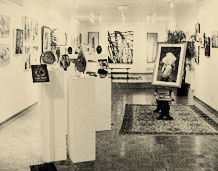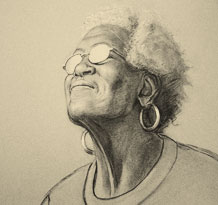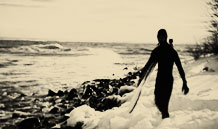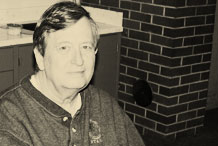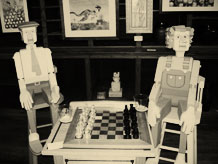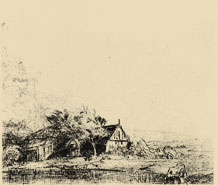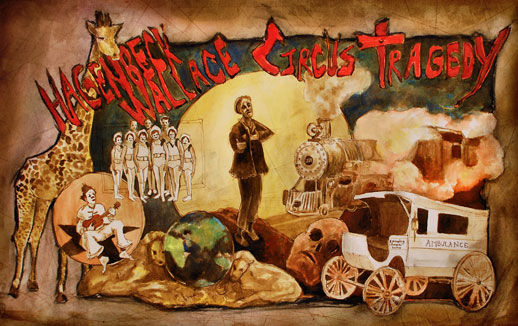
Illustration by Sophia Rapata [photo by Sophia Rapata]

...There’s Fire!
October 30, 2012
“Big Joe” made a mad dash and leapt atop of the wrecked heap and started to thrash the debris away. He followed the pleas of his son like a hunting dog on the scent of its quarry; tossing a splintered piece of wood, shattered beam, plank by broken plank. The fires around him started to grow and come closer. His son’s cries came louder. With the flames surrounding him, burning, he pulled away one final sheet of debris. Lit by the closing flames he could see the face of little Joe Jr.
“Daddy! Help me out. I’m burning!” A huge flame rushed over them. Hands grasped around “Big Joe” Coyle, pulling him away from death’s grip. Sadly, his wife and two young sons were left behind.
The lucky ones were thrown or pulled from the wreckage. Though the lucky ones would be witness to the horror of those who were burned alive. Henry Miller, Bud Gormond and ticket seller A. F. Roberts would later recount the scene. A little boy, the performer known as the “Human Encyclopedia” wept at the side of the Strong Man’s corpse, crushed by a heavy beam. One woman trapped in the burning wreckage cried aloud, “Oh God! Oh God! Kill me! Kill me!” whilst another screamed, “Shoot me! Kill me! Don’t let me be burned alive!”
The smell of burning flesh, the sound of blood chilling screams would forever be emblazoned in the backs of the survivors’ minds for the rest of their lives. These were not just coworkers. These were their friends, their family. Nothing could be done but shed tears and recite prayers for the burning condemned.
Firemen from Gary were the first responders to arrive. Though no water was available, they tried to break through the twisted and shattered remains with their axes to save any unfortunate souls. Unfortunately the heat from the fire was too overpowering and they had to retreat.
It wasn’t until 4:45 in the morning that water arrived to douse the flames. An engine pulling a tank of water from the Gibson train yard came upon the scene but by then not much more could be done for the victims trapped in the burning heap of hell. What victims were saved had been rushed to four local hospitals; one being St. Margaret’s in Hammond.
Eventually the fire was extinguished and the sifting through debris for bodies commenced. Gruesome discoveries were made. Severed fingers were found along side of the tracks. Two male bodies, severely burned, were uncovered sandwiched between two mattresses. On their faces were the frozen expression of horror and pain. Under the cow catcher of engine 8584, a skull was revealed, blackened by the heat and flames.
On the grounds of where the circus was to take place, manager Gollmar sat in a ticket booth. Lined up outside were the injured survivors. Gollmar tallied those who were present, making a list of those who were lost. Meanwhile, at the sight of the wreck, the last bodies were being recovered; “Little Joe” Coyle, lying on top of his brother and mother, all singed and burned by the fire. Later, when interviewed by a reporter, circus clown Joe Coyle was quoted saying, “The kiddies had been so glad to see their daddy. I wish I could have died with them.”
In all 86 people died from the train wreck and a total of 126 were injured. In Woodlawn Cemetery in the town of Forest Park a common grave was dug out, 35 feet by 24 feet by 5 feet deep. Interred were 56 bodies. Only three could be identified, the rest too burned to recognize. This section is known as Showmen’s Rest. A funeral was held for the victims. 1,500 family, friends and mourners attended. There to grieve the loss of his wife and two young sons was “Big Joe” Coyle.
As they say, the show must go on, and so it did. On June 25, 1918, the Hagenbeck-Wallace Circus performed in Beloit Michigan, only missing two shows; the one in Hammond and their next stop, Monroe Wisconsin. This was made possible with the help of competitors Ringling Brothers and the Barnum & Bailey Circuses. They contributed performers, workers and supplies so that the Hagenbeck-Wallace Circus could complete its performance season.
That Christmas the circus performed in French Lick Indiana, under the six story dome of the West Baden Hotel (though at the time it was converted into the U.S. Army General Hospital No. 35) for the injured troupes of WWI. Three days later Edward Ballard sold the outfit to Jerry Mugiven and Bert Bowers.
Eventually “Big Joe” Coyle left the Hagenbeck – Wallace Circus. He spent thirty three weeks in 1922 managing the sixth and seventh editions of the George White Scandals, a show much like the Ziegfeld Follies where many famous performers got their start, such as W.C. Fields, the Three Stooges, Ray Bolger, and Ethel Merman among many others. But he missed the life of a clown and eventually returned to entertaining children. The last we hear of Joe Coyle was in late 1944. He was living at 10 West Elm Street, Chicago Illinois. With his clown wardrobe and makeup copyrighted he performed for the kiddies at children’s parties and was employed by the retailers in the downtown loop as Koko the Clown. He would also be remembered by many as Montgomery Wards Christmas Clown.



